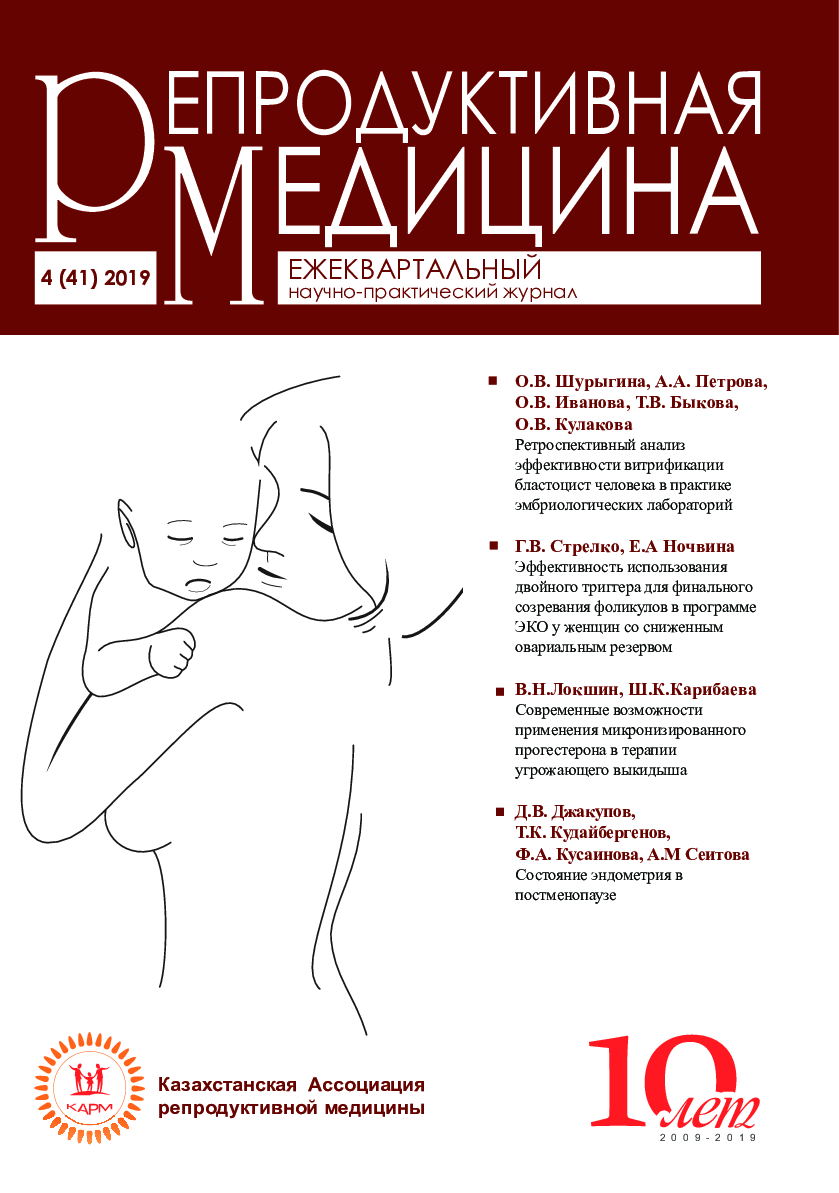Effectiveness of using the double trigger for final maturation of folicules in the IVF program in women with a reduced ovarial reserve
Keywords:
final oocyte maturation trigger, human chorionic gonadotropin, agonist GnRH, poor responsersAbstract
PURPOSE OF THE RESEARCH
Research of the effectiveness of the use of the double trigger of HCG + aGnRH in women with a reduced response to stimulation by estimating the number of received oocytes, splitting the embryos, pregnancy and implantation rates.
MATERIALS AND METHODS
Research was conducted on the performance of the use of the double trigger HCG + aGnRH in women – “poor responsers”
in comparison with the introduction of HCH only as a traditional trigger.
RESULTS
By analyzing the results of the proposed stimulation scheme using a double trigger in “bad responsers”, a statistically significant difference in the number of received oocytes, their maturity, embryo transfer frequency and pregnancy rate was proved.
CONCLUSION
It was found that in women with a reduced response to stimulation, the introduction of the double trigger of final follicular
maturation statistically significantly affects the number of oocytes with a relatively high level of MII, which also significantly
increases the pregnancy rate not only due to the generation of more mature oocytes, but also due to the effect on abnormal
endocrine profile, which takes place in this contingent of women.
References
Kol S. Luteolysis induced by a gonadotropin-releasing hormone agonist is the key to prevention of ovarian hyperstimulation syndrome, Fertility and Sterility, vol. 81, no. 1, pp. 1–5, 2004.
Humaidan P., S. Kol, and E. G. Papanikolaou, “GnRH agonist for triggering of final oocyte maturation: time for a change of practice?”Human Reproduction Update, vol. 17, no. 4, pp. 510–524, 2011.
Humaidan P., H. Ejdrup Bredkjær, L. G. Westergaard, and C. Yding Andersen, “1,500 IU human chorionic gonadotropin administered at oocyte retrieval rescues the luteal phase when gonadotropin-releasing hormone agonist is used for ovulation induction: aprospective, randomized, controlled study, ”Fertility and Sterility, vol. 93, no. 3, pp. 847–854, 2010.
Oktay K., I.T¨urkc ¸uoˇglu, and K.A.Rodriguez-Wallberg,“GnRH agonist trigger for women with breast cancer undergoing fertility preservation by aromatase inhibitor/FSH stimulation,” Reproductive BioMedicine Online, vol. 20, no. 6, pp. 783–788, 2010.
Bodri D., J. J. Guill´en, A. Galindo, D. Matar´o, A. Pujol, and O. Coll, “Triggering with human chorionic gonadotropin or a gonadotropin-releasing hormone agonist in gonadotropinreleasing hormone antagonist-treated oocyte donor cycles: finding sofalarge retrospective cohort study,” Fertility and Sterility, vol. 91, no.2, pp. 365–371, 2009.
Humaidan P., N. P. Polyzos, B. Alsbjerg et al., “GnRHa trigger and individualized luteal phase hCG support according to ovarian response to stimulation: two prospective randomized controlledmulti-centrestudiesin IVF patients,”Human Reproduction, vol. 28, no.9, pp. 2511–2521, 2013.
Castillo J. C., M. Dolz, E. Bienvenido, L. Abad, E. M. Casan, and F. Bonilla-Musoles, “Cycles triggered with GnRH agonist: exploring low-dose HCG for luteal support,” Reproductive BioMedicine Online, vol. 20, no. 2, pp. 175–181, 2010.
Acevedo B., J. L. Gomez-Palomares, E. Ricciarelli, and E. R. Hern´andez,“Triggering ovulation with gonadotropin-releasing hormone agonists does not compromise embryo implantation rates, ”Fertility and Sterility, vol. 86, no. 6, pp. 1682–1687, 2006.
Melo M., C. E. Busso, J. Bellver et al. “GnRH agonist versus recombinant HCG in an oocyte donation programme: a randomized, prospective, controlled, assessor-blindstudy, Reproductive BioMedicine Online, vol. 19, no. 4, pp. 486–492, 2009.
Castillo J.C., M. Dolz, J. Morenoetal. Triggering with GnRH agonist in oocyte-donation cycles: oestradiol monitoring is not necessary during ovarian stimulation, Reproductive BioMedicine Online, vol. 24, no. 2, pp. 247–250, 2012.
Additional Files
Published
How to Cite
Issue
Section
License
The articles published in this Journal are licensed under the CC BY-NC-ND 4.0 (Creative Commons Attribution – Non-Commercial – No Derivatives 4.0 International) license, which provides for their non-commercial use only. Under this license, users have the right to copy and distribute the material in copyright but are not permitted to modify or use it for commercial purposes. Full details on the licensing are available at https://creativecommons.org/licenses/by-nc-nd/4.0/.





